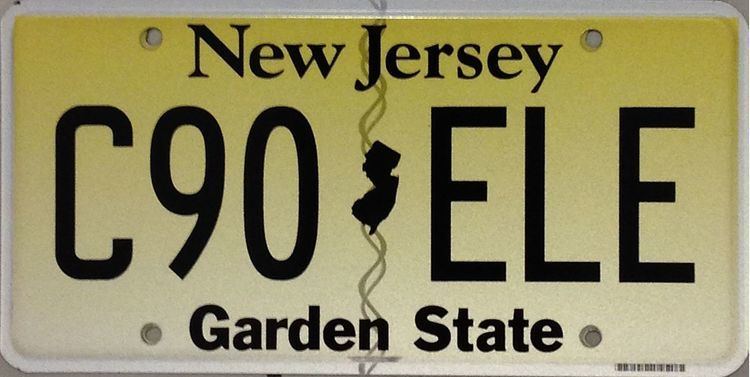 | ||
The U.S. state of New Jersey first issued license plates in 1908. Plates are currently issued by the New Jersey Motor Vehicle Commission.
Contents
- Issuance and validation
- Passenger baseplates 1908 to present
- Courtesy plates
- Current plate types
- Sports
- References
All bases of all classes of plates from 1959 to present are still valid for display in New Jersey. Since 2004, passenger plates have no requirement to display proof of valid registration, using only the registration card issued to the driver, which is stored in the glove box or on the person. New Jersey issues both front and rear license plates for almost all classes of vehicles, but "USED CAR DLR", "BICYCLE", "TRICYCLE", "SCOOTER", "MOTORCYCLE", "OXBOARD", and "SEGWAY" plates only issue rear.
Issuance and validation
Passenger plates were issued in pairs 1908 to present except for 1944, 1945, and 1946. New plates were issued every year until 1943 due to wartime restrictions. From 1943 until 1952 plates were issued yearly. Between 1953 and 1956 metal tabs were issued for re-validation of plates. In 1956 re validation began with front windshield stickers. In 1999 the state tried re-validating plates with stickers, but that scheme ended in 2004 with stickers issued to expire in 2005. Since then passenger plates have been re-validated with just the registration card issued to the driver.
Passenger baseplates 1908 to present
In 1956, the U.S. states and Canadian provinces came to an agreement with the Automobile Manufacturers Association that standardized the size for license plates for vehicles, except those for motorcycles, at six inches in height by twelve inches in width, with standardized mounting holes. The plates issued in 1955 were the first New Jersey license plates that complied with these standards.
Notes
Courtesy plates
Courtesy plates are issued to individuals with political connections. The serial formats on these plates consist of three letters followed or preceded by a number between 1 and 20. On standard courtesy plates the first letter is a county code, the second letter is the first initial of the vehicle owner's name, and the third letter is the initial of the last name of the vehicle owner. Courtesy plates may also be personalized, with all three letters making up the owner's initials.
Courtesy plates must be approved by a NJ State Senator from the applicant's election district prior to being submitted to the MVC. The staff for the applicant's senator must also get approval from the state senator from the county that corresponds to the first letter on the plate being requested. The letter Q cannot be used on these plates, and D, O, T, and X cannot be used as the first letter.
Current plate types
All plates issued since 1959 are still valid for use.
Sports
The New Jersey sports plates were introduced in the fall of 2010. They share a common serial format – RM12AB – and were the first NJ plates to be issued with screened, rather than embossed, serials.
